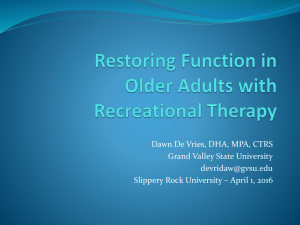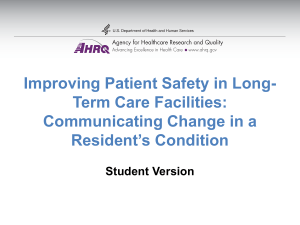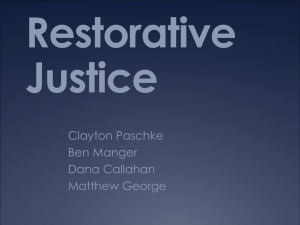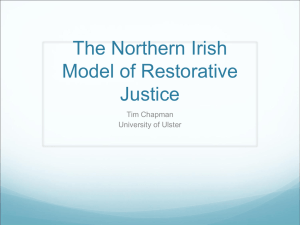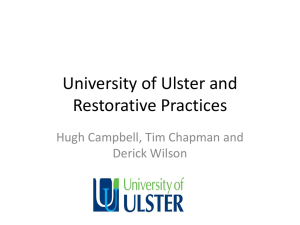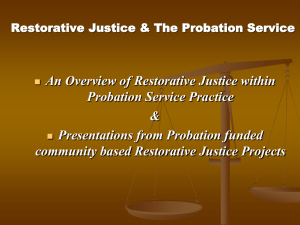MS PowerPoint Format
advertisement
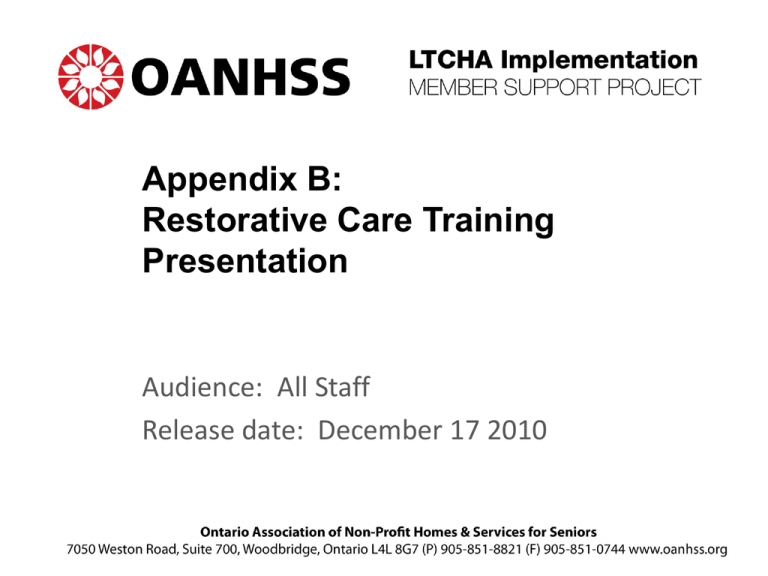
Appendix B: Restorative Care Training Presentation Audience: All Staff Release date: December 17 2010 Objectives At the completion of this session, participants will be able to: • Understand the principles of Restorative Care as related to the Long-Term Care Homes Act (LTCHA) 2007 • Define Restorative Nursing • Define Therapy Services • Understand the restorative care planning process • Understand the basic documentation requirements Restorative Care Utilizes skills and expertise of each discipline to plan, implement and facilitate returning an individual to their highest practicable physical, mental and psychosocial functional level. It is not a new concept… Restorative Care…cont’d Principles to be applied in the Long Term Care Home: • Providing resident focused care based on the resident’s needs and desires • Fostering the individual resident’s independence and quality of life • Optimizing the resident’s remaining strengths and abilities to attain and maintain optimal level of function possible and to prevent or delay deterioration • Promoting an interdisciplinary team approach to resident care • Promoting quality of working life for caregivers Restorative Care…cont’d • Is a philosophy of care – an approach to all interactions with residents • Is a process of care that embodies the nursing and interdisciplinary team care planning process • • • • Assessment Planning Implementation Evaluation • Involves use of MDS RAI 2.0, and is a key aspect of complying with the new Long-Term Care Homes Act, 2007 (including Quality Inspection) Nursing Restorative Care • Refers to nursing interventions that promote the resident’s ability to adapt and adjust to living as independently and safely as is possible. • This approach actively focuses on the resident achieving and maintaining optimal physical, mental, and psychosocial functioning. Nursing Restorative Care …cont`d • Focus is on resident skill development or support required for ADLs • A co-ordinated team approach • Interventions are provided under the direction of and evaluated by Registered Nursing staff Nursing Restorative Care …cont`d Includes: • Range of motion (active and passive) • Bed mobility • Transfers • Walking • Dressing or grooming • Eating and swallowing • Communication • Amputation or prosthesis care • Other (i.e. teaching for self care for diabetic management, self admin of medications etc) Transfers and Positioning • When transferring and positioning a resident, staff shall use devices and techniques that maintain or improve, wherever possible, his/her weight bearing capability, endurance and range of motion. Therapy Services What: Therapeutic interventions can include: • use of modalities • specific treatment techniques • retraining or teaching new skills to residents Who: These services are usually provided by a Physiotherapist (PT), Occupational Therapist (OT) or Speech and Language Pathologist (SLP) Why: The focus of the therapeutic interventions is to address a clinical issue such as illness, injury or disease. How: PT, OT, SLP are provided under the clinical direction of, and evaluated by the relevant therapist. The interventions may be carried out by the therapist or trained support personnel. Therapy Services…cont`d On-site therapy must be available to meet the needs of residents and may be accessed through contracted services, community resources or directly through the home. It is provided to residents on an individualized basis or in a group setting based on residents’ assessed care needs. Example of a Restorative Care Policy The home shall ensure that restorative care approaches and principles aimed at improving, preventing deterioration or maintaining a resident’s functional level and quality of life are integrated into home programs and the individual care plans for all residents. Procedure Follow the care planning process: • • • • Assessment: MDS RAI 2.0 Planning: Resident Focused Goals and Strategies Implementation: Continuity - according to the care plan Monitor and Evaluate: MDS RAI, resident satisfaction Required Documentation Individual resident • Flow sheets • Progress as it occurs • Changes in resident’s status • Quarterly review (or more frequent if required) Restorative Programs • Annual Program Evaluation Program Requirements • Written program descriptions including resident focused goals, program protocols, risk management , monitoring and evaluation aimed at improving or maintaining the resident’s function. Education Requirements • Staff and support personnel carrying out restorative interventions must be trained in restorative techniques. • Therapists providing service must be licensed to practice under the Ontario Regulated Health Professions Act, 1991. • Social Workers and Social Service Workers must be registered under the Ontario Social Work and Social Service Work Act, 1998. Resource Requirements Under the LTHCA, Homes must ensure: • Access to specialized resources such as OT, PT, SLP and referral process for specialized services, • Suitable supplies, assistive devices and equipment are available, safe for resident use, and in good working order. Skill Training Staff Training includes, but is not limited to: • Range of motion (active and passive) • Bed mobility • Transfers • Walking • Dressing or grooming • Eating and swallowing • Communication • Amputation or prosthesis care • Other (i.e. teaching for self care for diabetic management, self admin of medications etc) • Documentation – MDS RAI, care planning, flow sheets, progress notes Questions?

